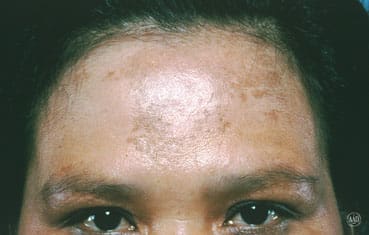Melasma Treatment
Melasma: What is it, and how can it be treated?
If you’ve noticed brown or grayish-brown blotches of skin on your face, it could be a condition called melasma. Melasma is a common skin problem, also called chloasma. While this condition is most common in women, some men also get it too. So, what exactly are these brown patches, and how can they be treated? Keep reading to find out more about the condition that is also known as “the mask of pregnancy.”

Melasma Symptoms
Melasma are patches of skin that are darker than your usual skin color. This happens when your skin produces excessive amounts of melanin. The patches typically develop around the ages of 20 and 40 years. Melasma on the face is often the most common place that these dark patches appear. The patches are symmetrical, with matching marks on both sides of the face. While the face is the most common location, these patches also appear on other parts of the body that are exposed to the sun.
Melasma are brownish-colored patches that usually appear on the:
- Cheeks
- Forehead
- Bridge of the nose
- Chin
- Temples
- Neck
- Forearms
Although the skin discoloration does not cause any physical harm, it can be embarrassing and can make you feel self-conscious. Unfortunately, melasma cannot be cured, but it can be effectively managed with sun protection measures and dermatologic care.
Melasma Skin Causes and Risk Factors
It’s not totally clear what causes melasma, but there are some factors that have been thought to trigger the condition.
- Skin tone – those with darker skin are at more risk than those with fair skin
- Hormones – estrogen and progesterone sensitivity are also associated with this condition. Pregnancy and oral contraceptives can trigger melasma because of the increase of estrogen in the body.
- Stress
- Thyroid disease
- Genetics – if you have family members who have melasma, you are more likely to develop the condition
- Sun exposure
Melasma Types and Diagnosis
Your doctor can typically diagnose melasma just by examining the area. Melasma will present itself as bilateral, asymptomatic, light-to-dark brown macules, or patches with irregular borders. Your melasma will be separated into a certain type, depending on the level of increased melanin in the skin:
- Epidermal Melasma
These are dark brown with a well-defined border. Treatment for this type usually has a good response. - Dermal Melasma
The borders on this type of melasma are ill-defined. These are light brown to blue-grey in color. Treatment for this type of melasma usually has a poor response. - Mixed Melasma
This is the most common type of melasma. These patches are blue-grey, light, and dark brown in color. Treatment with this usually shows partial improvement.If your doctor thinks the area looks suspicious, they may perform some tests:
- Wood’s lamp examination
A special kind of light is held up to the skin. The light will show your doctor if there are any bacterial or fungal infections. It will also show your dermatologist just how deep the melasma penetrates the skin. - Biopsy
This will involve removing a small piece of the skin so it can be examined. A dermatologist can safely and quickly perform a skin biopsy during your office visit.
- Wood’s lamp examination
Related Pages
- Treatment for Flaky Facial Skin from Dandruff and Rosacea
- Glytone
- Avene
- Microblading vs. Eyebrow Tattooing: What’s the Difference, and Why Does it Matter?
- Forehead Botox: Everything You Need to Know about the Cost, Risks, and Benefits
- Bellafill: A Long-Lasting, Effective Dermal Filler Solution
- Sebaceous Hyperplasia: Causes, Symptoms, and Treatment
- Laser Hair Removal: The Superior Alternative
- Neck Lift
- Wrinkle Treatment
- Molluscum
- Seborrheic Keratosis
- Mole Removal
- Actinic Keratosis
- Contact Dermatitis
- Itchy Scalp Treatment
- Atypical Nevi
- Hyperhidrosis Treatment
- Melasma Treatment
- Cysts Treatment
- Psoriasis
- Warts Treatment
- Eczema Treatment
- Seborrheic Dermatitis Treatment
- Rosacea Treatment
- Fungal Infections
- Hair Loss Treatment
- Acne Treatment
Quick Quote
Melasma Treatment Options
If melasma is caused by pregnancy or birth control pills, then the patches will typically go away on their own after a woman gives birth or stops taking birth control pills. However, some people can experience melasma for years, or even for their entire lifetime. If you want to get rid of it, your healthcare provider can recommend some options to lighten the skin:
- Topical steroids
- Chemical peels
- Dermabrasion
- Microdermabrasion
These procedures do not guarantee that your melasma will not come back. And in some cases, melasma cannot be completely lightened. You may have to repeat these treatments to see results. You may also have to develop a skincare regime that you discuss with your doctor that may reduce the risk of the melasma returning.
Living with Melasma
While melasma is not life-threatening, it can impact your self-esteem. If your melasma does not completely clear up with treatment, or if it returns, you will have to find ways to live with the condition. Here are some things you can do to minimize the appearance of the discoloration on the face:
- Use makeup to cover up the areas
- Take a prescription medication your doctor has prescribed
- Wear sunscreen with SPF 30 every day even when it is cloudy
- Wear a wide-brimmed hat that shields your face from the sun
Treat Your Melasma with the Experts at Winston Salem Dermatology
If you are tired of dealing with melasma, let us help. We can take a look at the dark patches on your skin and find out the best way to treat the condition. It is our goal to help you understand how to maintain the health and beauty of your skin, no matter what stage of life you may be in. No matter what your problem is, we have a solution that will be customized for your skincare goals. We do everything we can to help you find the perfect skincare solution. If you would like to know more about minimizing your melasma or about any other services that we have, feel free to give us a call at (336) 774-8636.
Related Pages
- Treatment for Flaky Facial Skin from Dandruff and Rosacea
- Glytone
- Avene
- Microblading vs. Eyebrow Tattooing: What’s the Difference, and Why Does it Matter?
- Forehead Botox: Everything You Need to Know about the Cost, Risks, and Benefits
- Bellafill: A Long-Lasting, Effective Dermal Filler Solution
- Sebaceous Hyperplasia: Causes, Symptoms, and Treatment
- Laser Hair Removal: The Superior Alternative
- Neck Lift
- Wrinkle Treatment
- Molluscum
- Seborrheic Keratosis
- Mole Removal
- Actinic Keratosis
- Contact Dermatitis
- Itchy Scalp Treatment
- Atypical Nevi
- Hyperhidrosis Treatment
- Melasma Treatment
- Cysts Treatment
- Psoriasis
- Warts Treatment
- Eczema Treatment
- Seborrheic Dermatitis Treatment
- Rosacea Treatment
- Fungal Infections
- Hair Loss Treatment
- Acne Treatment
Quick Quote
Address
Winston Salem Dermatology & Surgery Center
1400 Westgate Center Drive,
Suite 200 - Winston Salem, NC 27103
Phone: 336.774.8636
Fax: 336.774.0265
www.WinstonSalemDermatology.com



